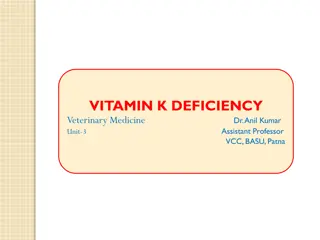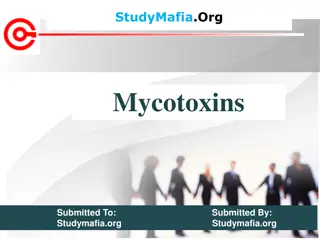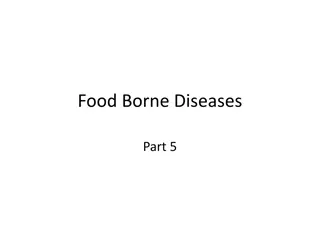FUNGAL SPECIES AND THEIR TOXINS.
Explore the world of fungal species and their toxins as studied by Prof. Abdullah Msaad Al-Falih at King Saud University's College of Science. Discover over 500 mycotoxins, including aflatoxins, ochratoxins, trichothecenes, fumonisins, sterigmatocystin, ergot alkaloids, zearalenone, Alternaria toxin
2 views • 8 slides
Food spoilage
In this lecture from the Department of Pathological Analyses at the University of Basrah, Prof. Dr. Saad S. Mahdi Al-amaradi Al-Amara discusses food spoilage, focusing on cereals, bakery foods, and meat products. The presentation covers the microbial spoilage of grains, including common mold species
0 views • 9 slides
Understanding Vitamin K Deficiency in Veterinary Medicine
Vitamin K deficiency in animals can lead to serious health issues due to its crucial role in blood clotting and bone metabolism. Different sources of vitamin K, such as plant material and bacterial fermentation, provide essential forms like K1 and K2. Factors contributing to deficiency include fat m
0 views • 8 slides
Understanding Mycotoxins: Risks, Sources, and Prevention
Mycotoxins are toxic substances produced by fungi that can be harmful to humans and animals. They can be found in various food items like nuts, cereals, and coffee beans, and are often spread through poor agricultural practices. Exposure to mycotoxins can lead to mycotoxicosis, causing serious healt
2 views • 18 slides
Understanding Aflatoxins: Mycotoxins and Toxicology in Plants
Mycotoxicoses refers to illnesses in humans or animals caused by ingesting substances produced by certain molds or fungi on food. Aflatoxins are a type of mycotoxin that are potent mutagens, carcinogens, teratogens, and liver damage agents. They were first discovered in the 1960s and are known to be
0 views • 16 slides
Understanding Fungal and Chemical Food-Borne Intoxications
Fungal intoxications are caused by mycotoxins produced by fungi in improperly stored food, with aflatoxicosis being a significant concern. Aflatoxins can lead to acute hemorrhagic syndromes and long-term liver tumors. Prevention strategies include proper drying and storage of foods. Chemical food-bo
0 views • 19 slides





